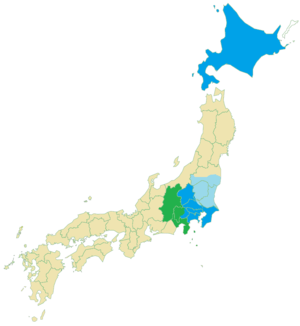Kantō dialect
| Kantō Japanese | |
|---|---|
| Native to | Japan |
| Region | Kantō region |
Native speakers | (no estimate available) |
| Language codes | |
| ISO 639-3 | – |
| Glottolog |
kant1251[1] |
|
Kanto dialects. Blue: Western Kantō and Hokkaidō. Azure: Eastern Kantō, transitional to Tōhoku. Green: Eastern Tōkai–Tōsan (Nagano–Yamanashi–Shizuoka), which lack the Western features of the more transitional Tōkai–Tōsan dialects. | |
The Kantō dialect (関東方言 kantō hōgen, 関東弁 kantō-ben) is a group of the Japanese dialects spoken in the Kantō region apart from the Izu Islands.[note 1] The Kanto dialect is including the Tokyo dialect which is the basis of the modern standard Japanese. Along with the Tohoku dialect, it has been characterized by a suffix -be or -ppe; Kanto speakers were called Kantō bei by Kansai speakers in the Edo period. The eastern Kantō dialect has more features common to the Tōhoku dialect. After the Pacific War, the southern Kanto regions such as Kanagawa, Saitama and Chiba prefectures developed as satellite cities of Tokyo, and today traditional dialects in these areas are almost replaced by standard Japanese.
The Kanto dialects are:
- Western Kantō
- Tokyo dialect (central Tokyo)
- Yamanote dialect (old upper-class dialect)
- Shitamachi dialect or Edo dialect (old working-class dialect)
- Tama dialect (Western Tokyo)
- Saitama dialect (Saitama Prefecture)
- Chichibu dialect (Chichibu)
- Gunma dialect or Jōshū dialect (Gunma Prefecture)
- Kanagawa dialect (Kanagawa Prefecture)
- Chiba dialect (Chiba Prefecture)[note 2]
- Bōshū dialect (Southern Chiba Prefecture)
- Gun'nai dialect (Eastern Yamanashi Prefecture)
- Tokyo dialect (central Tokyo)
- Eastern Kantō
- Ibaraki dialect (Ibaraki Prefecture)
- Tochigi dialect (Tochigi Prefecture)
Kanto Japanese in other regions
The Hokkaidō dialect is most similar to Standard Japanese because colonists from various regions settled the area, thus requiring the use of standard language in order to facilitate communication. In the Ryukyu Islands, Standard Japanese developed into a dialect known as Okinawan Japanese, which has been influenced by Ryukyuan languages.
Notes
- ↑ In northern Izu Islands are Tokai–Tosan dialects, and in the southern islands are the Hachijō dialects.
- ↑ northern Chiba Prefecture is a transitional area between Western and Eastern Kanto
